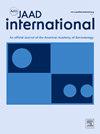Association between dermoscopic features and tumor thickness, diameter, age, and sex in acral melanoma: A cross-sectional study
IF 5.2
引用次数: 0
Abstract
Background
Although dermoscopy is useful for the early detection of acral melanoma (AM), the relationships of dermoscopic findings with factors such as tumor thickness (TT), lesion diameter, patient’s age, and sex remain unclear.
Objective
To investigate the relationships of dermoscopic findings with TT, lesion diameter, patient sex, and age.
Methods
Ninety-four patients with AM were included in the retrospective cross-sectional study. Multivariate analysis was performed to determine the relationships of dermoscopic findings with TT, diameter, age, and sex.
Results
Compared to in situ lesions, lesions with TT > 4 mm had significantly more irregular dots, blue-gray clods, blood crusts, shiny white lines, and blood vessels, and significantly less parallel ridge patterns. Regression structures and the micro-Hutchinson sign were commonly observed in situ. With an increase in diameter, the number of peripheral black dots decreased predominantly. With an increase in age, regression structures and milky red globules became more frequent. Blood vessels were more commonly found in women.
Limitations
This was a retrospective study with a small sample size that included patients with nail melanoma.
Conclusions
TT, diameter, age, and sex may affect dermoscopic findings of AM. Clinicians should consider these factors when examining patients with acral pigmentation.
肢端黑色素瘤皮肤镜特征与肿瘤厚度、直径、年龄和性别之间的关系:一项横断面研究
虽然皮肤镜检查对肢端黑色素瘤(AM)的早期发现很有用,但皮肤镜检查结果与肿瘤厚度(TT)、病变直径、患者年龄和性别等因素的关系尚不清楚。目的探讨皮镜检查结果与TT、病变直径、患者性别、年龄的关系。方法对94例AM患者进行回顾性横断面研究。进行多变量分析以确定皮镜检查结果与TT、直径、年龄和性别的关系。结果与原位病变相比,TT和gt病变;4mm明显有更多不规则的点、蓝灰色的土块、血痂、闪亮的白线和血管,平行脊纹明显更少。原位常观察到回归结构和微哈钦森征。随着直径的增大,周边黑点数量明显减少。随着年龄的增长,退行性结构和乳红色球变得更加频繁。血管更常见于女性。局限性:这是一项小样本量的回顾性研究,包括指甲黑色素瘤患者。结论stt、直径、年龄和性别可能影响AM的皮肤镜表现。临床医生在检查肢端色素沉着患者时应考虑这些因素。
本文章由计算机程序翻译,如有差异,请以英文原文为准。
求助全文
约1分钟内获得全文
求助全文

 求助内容:
求助内容: 应助结果提醒方式:
应助结果提醒方式:


